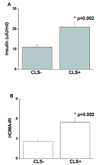Adipose macrophage infiltration is associated with insulin resistance and vascular endothelial dysfunction in obese subjects
- PMID: 18566296
- PMCID: PMC2728436
- DOI: 10.1161/ATVBAHA.108.170316
Adipose macrophage infiltration is associated with insulin resistance and vascular endothelial dysfunction in obese subjects
Abstract
Objective: Experimental studies suggest that adipose inflammation is etiologically linked to obesity-induced systemic disease. Our goal was to characterize the state of inflammation in human fat in relation to vascular function and metabolic parameters in obese individuals.
Methods and results: We collected subcutaneous abdominal fat in 77 obese subjects (BMI >or=30 kg/m(2)) and quantified adipose macrophage population using targeted immunohistochemistry. Brachial artery vasodilator function was examined using high-resolution vascular ultrasound. In 50 subjects, an inflamed adipose phenotype characterized by tissue macrophage accumulation in crown-like structures was associated with systemic hyperinsulinemia and insulin resistance (HOMA-IR 5.5+/-4.5 versus 2.6+/-1.9, P=0.002) and impaired endothelium-dependent flow-mediated vasodilation (8.5+/-4.4% versus 10.8+/-3.8%, P<0.05), as compared to subjects with quiescent noninflamed adipose architecture (n=27). Macrophage retention in fat was linked to upregulated tissue CD68 and tumor necrosis factor (TNF)-alpha mRNA expression in addition to increased plasma hs-CRP.
Conclusions: In a cohort of obese subjects, we demonstrate that proinflammatory changes in adipose tissue are associated with systemic arterial dysfunction and insulin resistance. These findings suggest that adipose inflammation may be linked to vascular injury and increased cardiovascular risk in obese subjects.
Figures




References
-
- Olshansky SJ, Passaro DJ, Hershow RC, Layden J, Carnes BA, Brody J, Hayflick L, Butler RN, Allison DB, Ludwig DS. A potential decline in life expectancy in the United States in the 21st century. N Engl J Med. 2005;352:1138–1145. - PubMed
Publication types
MeSH terms
Substances
Grants and funding
LinkOut - more resources
Full Text Sources
Other Literature Sources
Medical
Research Materials
Miscellaneous

